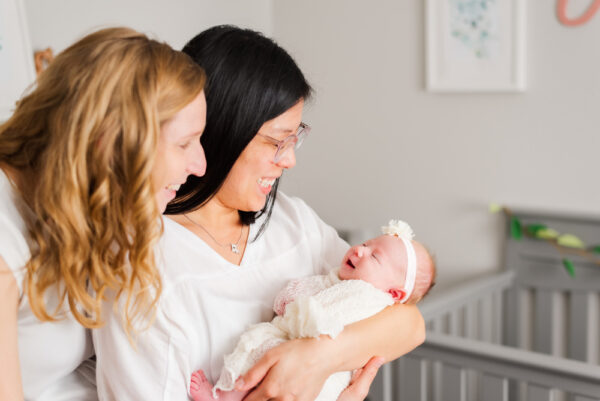Reciprocal IVF allows lesbian couples to share the joy of pregnancy and parenthood
At Fertility Specialists of Texas, we love empowering our patients to customize their paths to parenthood. When it comes to lesbian family-building, one of the most exciting options for our patients is reciprocal IVF. Also known as co-IVF, this method allows both partners in a relationship to play an active role in fertility treatment at our LGBT fertility center. It also is a great way for both women to share a special connection with their children.
We can help you get started with co-IVF
At your first fertility appointment, your doctor will ask about your medical history and order some basic fertility tests. They’ll also ask about your family-building goals. If you have a partner and you’re both interested in participating in the treatment process, your doctor will likely suggest reciprocal IVF.
In this arrangement, one partner provides the eggs for the pregnancy while the other carries and delivers the baby. The test results for you and your partner can help you determine who should play which role. Generally, the younger partner or the partner with the better egg supply and no fertility issues should consider providing her eggs.
Once you’ve decided on your roles, you’ll need to select a sperm donor. You can select an anonymous donor from a sperm bank or ask someone you know to be your donor. As soon as you pick your donor, our LGBT fertility center can help you both get started with IVF.
Our team would be honored to guide you through reciprocal IVF
The partner who will carry the pregnancy will take an estrogen-based medication to prepare her uterine lining to accept an embryo. As for the partner who will provide her eggs, she will take injectable fertility medications. The goal is to encourage her ovaries to produce multiple eggs at the same time.
Once the patient’s eggs are mature (the lead follicles are 18-20 mm), the doctor will order an injection to trigger ovulation (egg release). About 36 hours later, the patient will have an outpatient egg retrieval procedure. This procedure only takes a few minutes.
For the next step, the embryologists in the IVF lab will fertilize the patient’s eggs with the donor sperm. The embryologist will then monitor the growth and development of the fertilized eggs as they turn into embryos.
Finally, the doctor will transfer a good-quality embryo to the uterus of the partner who will be carrying the pregnancy. This is a short procedure that involves placing a thin, flexible tube (catheter) through the vagina and the cervix to reach the uterus and deposit an embryo.
Two weeks later, the patient will return to the clinic for a blood pregnancy test. If the result is positive, we will care for her for the first few weeks of pregnancy until releasing her to her obstetrician.
Co-IVF is a beautiful way to share the joy of pregnancy and parenthood with your partner. Contact our LGBT fertility center if you’d like to learn more about reciprocal IVF.



